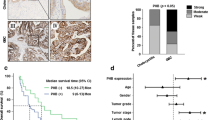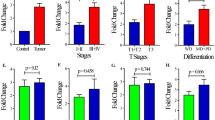Abstract
The chloride intracellular channel 1 (CLIC1) gene family is a recently identified class of Cl channel proteins. Although CLIC1 involvement is well established in some cancers such as gastric cancer and colon cancer, its expression pattern in gallbladder cancer (GBC) remains unknown. The aim of our study was to investigate the expression of CLIC1 in relation to progression and prognosis of GBC. Eight fresh gallbladder cancers paired with adjacent non-tumour tissues were quantified using real-time PCR and Western blot. Tissue samples from resected gallbladder cancer (n = 75) and cholelithiasis (n = 75) were evaluated for CLIC1 expression by immunohistochemical staining. Their expression was correlated with different clinicopathological parameters. CLIC1 expression was significantly higher (62.7 %) in gallbladder cancer than in cholelithiasis (21.3 %, p < 0.001). CLIC1 levels were associated with the histological grade, TNM stage and perineural invasion (p < 0.05), but not with patient age, sex, lymph node metastasis or gallbladder stones (p > 0.05). Univariate Kaplan–Meier analysis showed that a positive CLIC1 expression was associated with a decreased overall survival (p < 0.001). Multivariate Cox regression analysis showed that CLIC1 expression and histological grade were independent risk factors for overall survival. Therefore, the expression of CLIC1 is closely related to the progression of GBC and may be used as an effective marker for predicting the prognosis of this disease.


Similar content being viewed by others
References
Siegel R, Naishadham D, Jemal A. Cancer statistics, 2013. CA Cancer J Clin. 2013;63(1):11–30.
Gourgiotis S, Kocher HM, Solaini L, Yarollahi A, Tsiambas E, Salemis NS. Gallbladder cancer. Am J Surg. 2008;196(2):252–64.
Goldin RD, Roa JC. Gallbladder cancer: a morphological and molecular update. Histopathology. 2009;55(2):218–29.
Lazcano-Ponce EC, Miquel JF, Muñoz N, Herrero R, Ferrecio C, Wistuba II, et al. Epidemiology and molecular pathology of gallbladder cancer. CA Cancer J Clin. 2001;51(6):349–64.
Maurya SK, Tewari M, Mishra RR, Shukla HS. Genetic aberrations in gallbladder cancer. Surg Oncol. 2012;21(1):37–43.
Kraljevic Pavelic S, Sedic M, Bosnjak H, Spaventi S, Pavelic K. Metastasis: new perspectives on an old problem. Mol Cancer. 2011;10:22.
Chen CD, Wang CS, Huang YH, Chien KY, Liang Y, Chen WJ, et al. Overexpression of CLIC1 in human gastric carcinoma and its clinicopathological significance. Proteomics. 2006;7(1):155–67.
Petrova DT, Asif AR, Armstrong VW, Dimova I, Toshev S, Yaramov N, et al. Expression of chloride intracellular channel protein 1 (CLIC1) and tumor protein D52 (TPD52) as potential biomarkers for colorectal cancer. Clin Biochem. 2008;41(14–15):1224–36.
Huang JS, Chao CC, Su TL, Yeh SH, Chen DS, Chen CT, et al. Diverse cellular transformation capability of overexpressed genes in human hepatocellular carcinoma. Biochem Biophys Res Commun. 2004;315(4):950–8.
Kim W, Oe Lim S, Kim JS, Ryu YH, Byeon JY, Kim HJ, et al. Comparison of proteome between hepatitis B virus-and hepatitis C virus-associated hepatocellular carcinoma. Clin Cancer Res. 2003;9(15):5493–500.
Wang W, Xu X, Wang W, Shao W, Li L, Yin W, et al. The expression and clinical significance of CLIC1 and HSP27 in lung adenocarcinoma. Tumour Biol. 2011;32(6):1199–208.
Chang YH, Wu CC, Chang KP, Yu JS, Chang YC, Liao PC. Cell secretome analysis using hollow fiber culture system leads to the discovery of CLIC1 protein as a novel plasma marker for nasopharyngeal carcinoma. J Proteome Res. 2009;8(12):5465–74.
Wang JW, Peng SY, Li JT, Wang Y, Zhang ZP, Cheng Y, et al. Identification of metastasis-associated proteins involved in gallbladder carcinoma metastasis by proteomic analysis and functional exploration of chloride intracellular channel 1. Cancer Lett. 2009;281(1):71–81.
Edge SB, Compton CC. The American Joint Committee on Cancer: the 7th edition of the AJCC cancer staging manual and the future of TNM. Ann Surg Oncol. 2010;17(6):1471–4.
Li M, Zhang S, Wang Z, Zhang B, Wu X, Weng H, et al. Prognostic significance of nemo-like kinase (NLK) expression in patients with gallbladder cancer. Tumour Biol. 2013;34(6):3995–4000.
Dong P, Zhang Y, Gu J, Wu W, Li M, Yang J, et al. Wogonin, an active ingredient of Chinese herb medicine Scutellaria baicalensis, inhibits the mobility and invasion of human gallbladder carcinoma GBC-SD cells by inducing the expression of maspin. J Ethnopharmacol. 2011;137(3):1373–80.
Pettinicchio M, Traini T, Murmura G, Caputi S, Degidi M, Mangano C, et al. Histologic and histomorphometric results of three bone graft substitutes after sinus augmentation in humans. Clin Oral Investig. 2012;16(1):45–53.
Zhang Z, Wang X, Wu W, Wang J, Wang Y, Wu X, et al. Effects of matrine on proliferation and apoptosis in gallbladder carcinoma cells (GBC-SD). Phytother Res. 2012;26(6):932–7.
Berry KL, Hobert O. Mapping functional domains of chloride intracellular channel (CLIC) proteins in vivo. J Mol Biol. 2006;359(5):1316–33.
Qiu MR, Jiang L, Matthaei KI, Schoenwaelder SM, Kuffner T, Mangin P, et al. Generation and characterization of mice with null mutation of the chloride intracellular channel 1 gene. Genesis. 2010;48(2):127–36.
Tulk BM, Kapadia S, Edwards JC. CLIC1 inserts from the aqueous phase into phospholipid membranes, where it functions as an anion channel. Am J Physiol Cell Physiol. 2002;282(5):C1103–12.
Ulmasov B, Bruno J, Woost PG, Edwards JC. Tissue and subcellular distribution of CLIC1. BMC Cell Biol. 2007;8:8.
Rahman A, Kumar SG, Kim SW, Hwang HJ, Baek YM, Lee SH, et al. Proteomic analysis for inhibitory effect of chitosan oligosaccharides on 3T3-L1 adipocyte differentiation. Proteomics. 2008;8(3):569–81.
Sun HJ, Bahk YY, Choi YR, Shim JH, Han SH, Lee JW. A proteomic analysis during serial subculture and osteogenic differentiation of human mesenchymal stem cell. J Orthop Res. 2006;24(11):2059–71.
Valenzuela SM, Mazzanti M, Tonini R, Qiu MR, Warton K, Musgrove EA, et al. The nuclear chloride ion channel NCC27 is involved in regulation of the cell cycle. J Physiol. 2000;529(Pt 3):541–52.
Li RK, Zhang J, Zhang YH, Li ML, Wang M, Tang JW. Chloride intracellular channel 1 is an important factor in the lymphatic metastasis of hepatocarcinoma. Biomed Pharmacother. 2012;66(3):167–72.
Wang WF, Li J, Du LT, Wang LL, Yang YM, Liu YM, et al. Krüppel-like factor 8 overexpression is correlated with angiogenesis and poor prognosis in gastric cancer. WJG. 2013;19(27):4309–15.
Acknowledgments
This work was supported by the National High Technology Research and Development Program (863 Program) (No. 2012AA022606), the National Natural Science Foundation of China (No. 81172026, 81272402, 81301816, 81402403 and 81172029), the Shanghai Committee of Science and Technology (No. 12JC1406700, 12410705900, 12401905800), the Leading Talent Program of Shanghai, Sailing Program of Shanghai Science and Technology Commission (No. 14YF1403000) and the Foundation of Shanghai Outstanding Academic Leaders (No. 11XD1403800).
Author contributions
Ding QC and Li ML contributed equally to this work; Liu YB designed the research; Ding QC, Li ML, Wu XS, Zhang L and Wu WG performed the research; Li ML, Wang XA, Ding Q and Weng H analysed the data; and Ding QC wrote the paper.
Conflicts of interest
None
Author information
Authors and Affiliations
Corresponding author
Additional information
Qichen Ding and Maolan Li contributed equally to this work.
Rights and permissions
About this article
Cite this article
Ding, Q., Li, M., Wu, X. et al. CLIC1 overexpression is associated with poor prognosis in gallbladder cancer. Tumor Biol. 36, 193–198 (2015). https://doi.org/10.1007/s13277-014-2606-5
Received:
Accepted:
Published:
Issue Date:
DOI: https://doi.org/10.1007/s13277-014-2606-5




